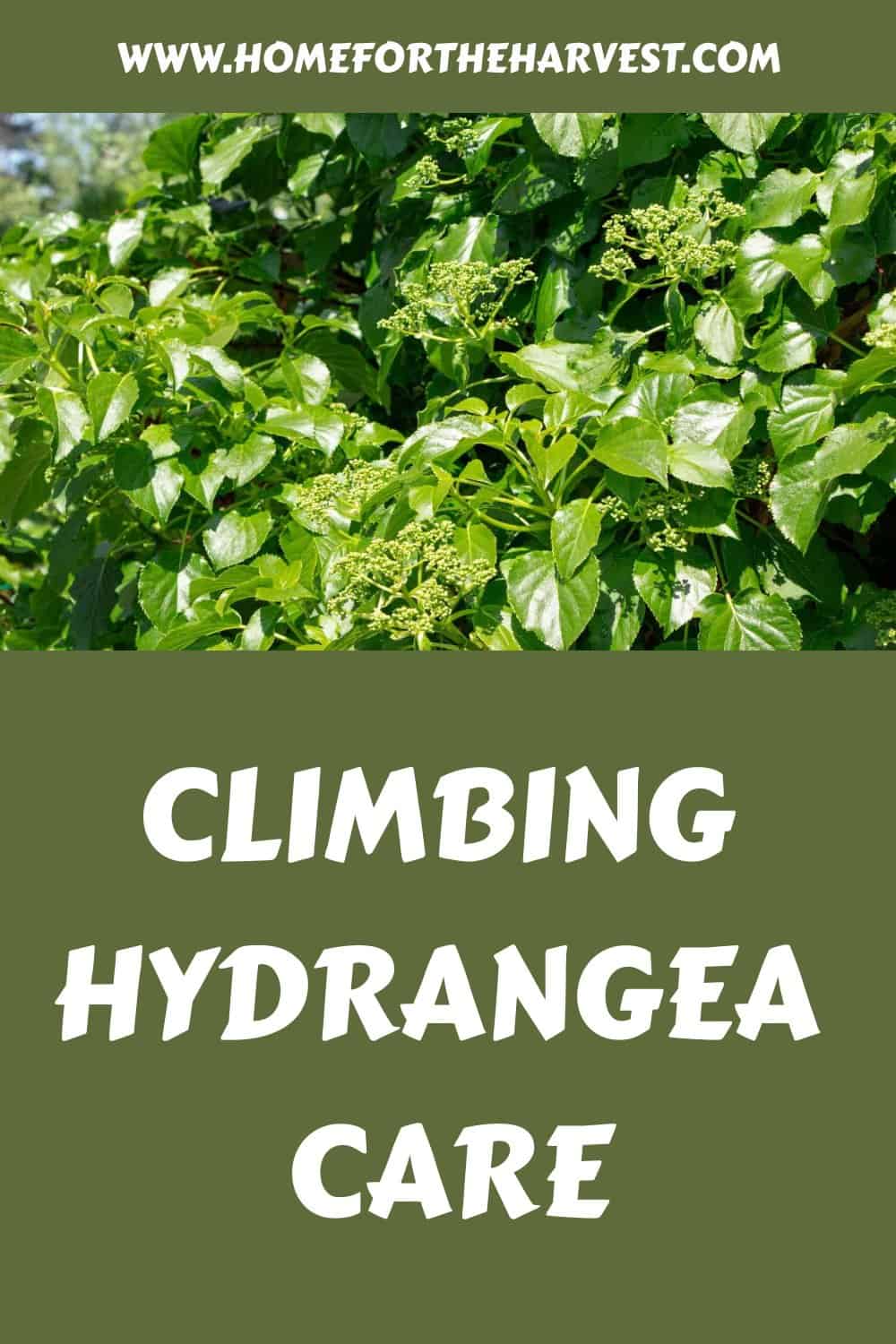Good climbing hydrangea care starts with selecting a planting location with moist, free-draining, slightly acidic soil. This plant is tolerant of full shade but grows best when the leaves receive direct sun (preferably in the morning). Fertilize the plant in spring and in summer after it blooms. Annual pruning is best done in the summer or fall after the flowers have started to fade.
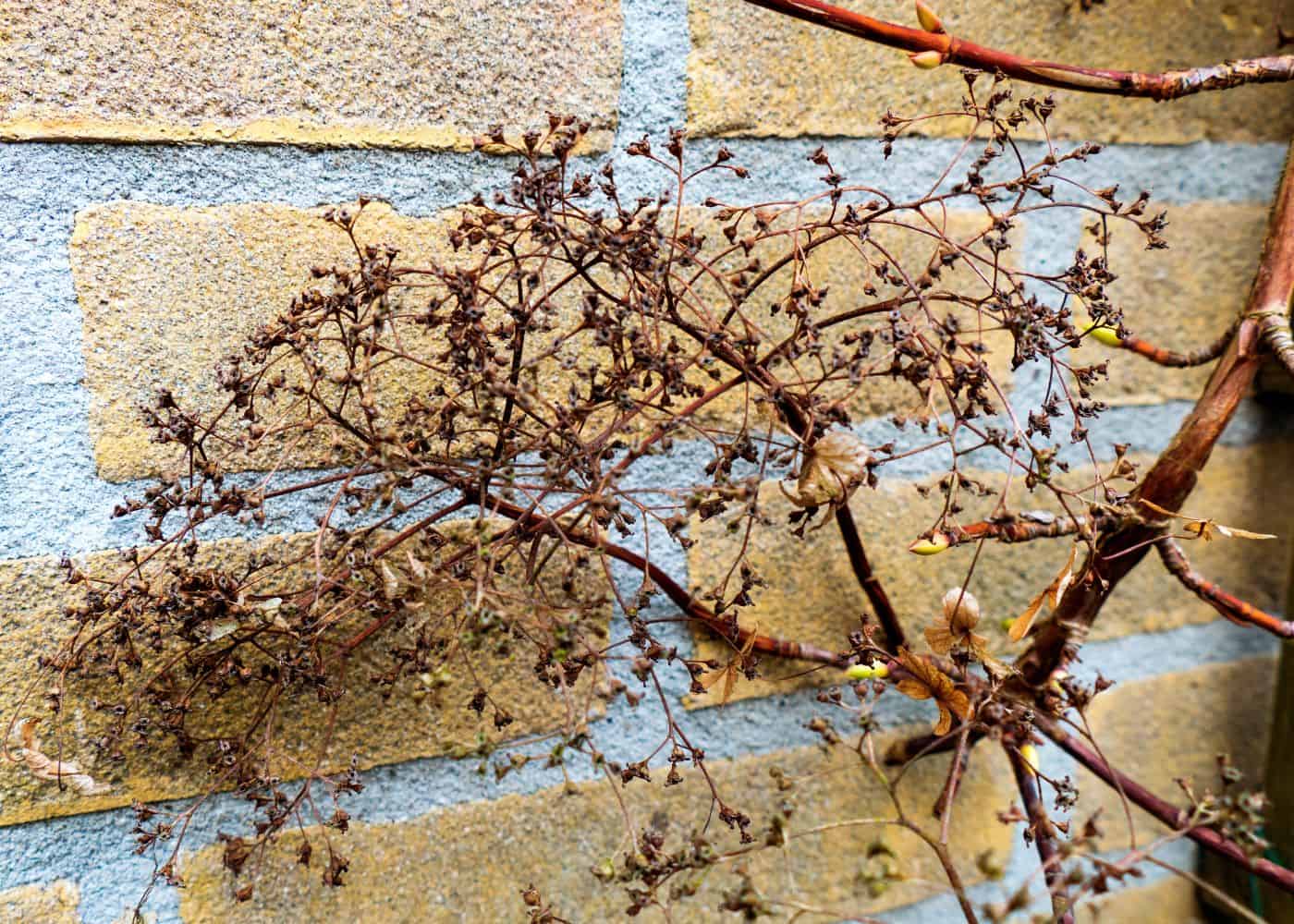
Climbing hydrangea care basics
Climbing hydrangeas are easy to care for and can provide years of enjoyment with their cascading blooms in the summer months. To ensure your climbing hydrangea (Hydrangea petiolaris, synonym Hydrangea anomala subsp. petiolaris) is healthy, there are some basics you should know about caring for it.
Start by planting the climbing hydrangea in an ideal location. These plants do best in moist, fertile soil with lots of nutrient-rich organic matter. The soil around your climbing hydrangea should be well-drained and slightly acidic, with a pH between 5 and 6.5 being ideal for this type of plant.
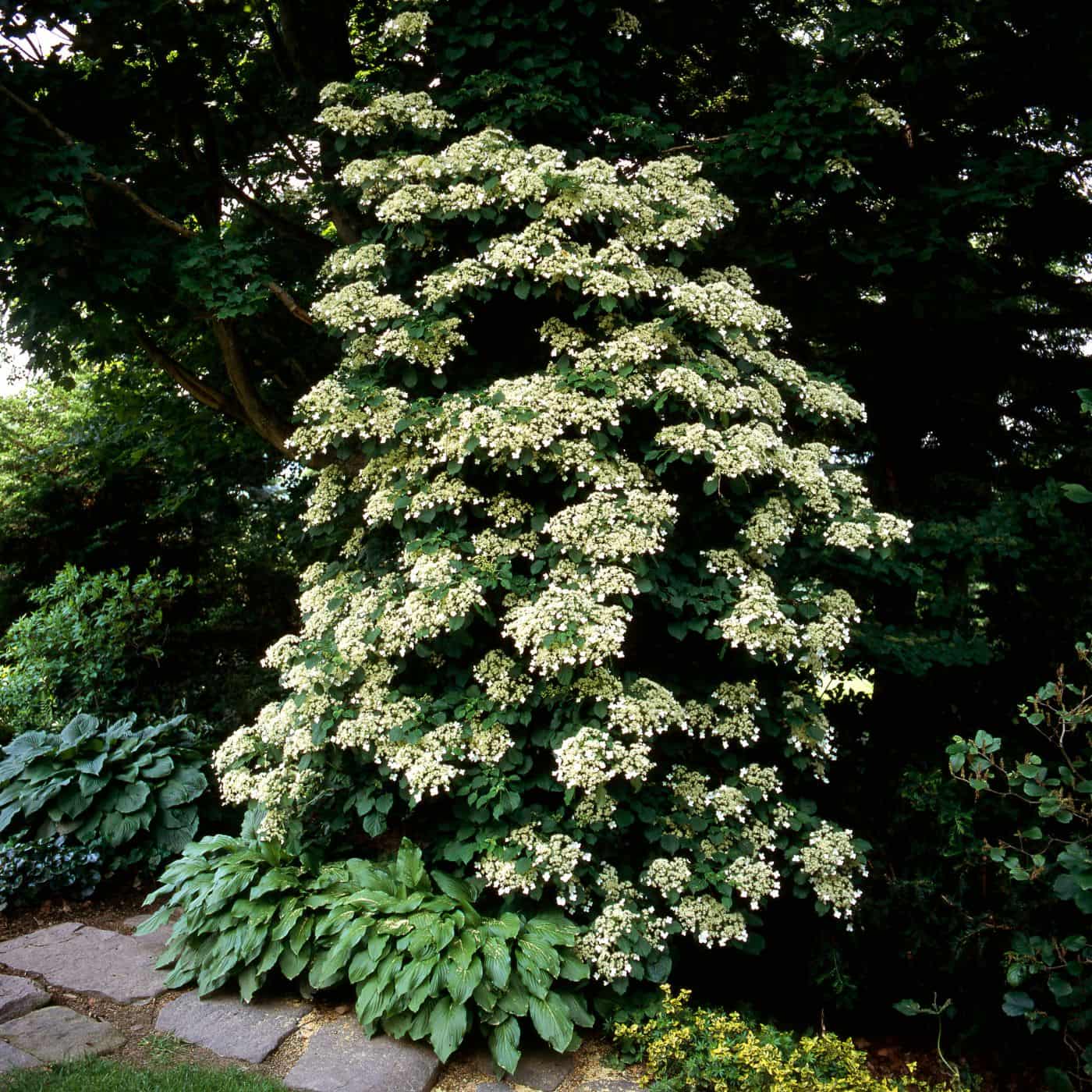
They also do best when the plant receives some direct sunlight. Morning sunlight is preferable to harsh afternoon rays, and a bit of shade at the base of the plant can be helpful for keeping soil temperatures steady, but the leaves do need a bit of light for the plant to grow quickly and flower well.
While climbing hydrangeas have self-clinging aerial roots, these twinning vines do best when helped along a trellis when they are young. Train young plants up a vertical surface where the leaves can access sunlight for ample photosynthesis.
If you haven’t had your garden soil tested already, now is the time. Not only will it give you an idea of the natural pH level of your soil, but the test will also let you know specifically which nutrients to add as fertilizer. Slow-release fertilizers work best for the long-term feeding of these plants and are easy to sprinkle on the soil and water.
Newly planted climbing hydrangeas need to be watered quite often, but you can decrease this frequent watering once the plant has been happily in the ground for a year or two. Water your established climbing hydrangea deeply but infrequently – once every week or two is usually enough unless temperatures get very high during the summer months, when more frequent watering may be necessary to prevent wilting leaves due to heat stress.
When watering, make sure all parts of the root system get moistened by using a hose or sprinkler head that reaches far enough out from the base of the plant so water penetrates down into the top foot or two of soil where roots are located rather than just wetting surface crust only.
Climbing hydrangeas do not need significant annual pruning. When they are pruned annually, the pruning is best done right after the blooms have faded. Depending on the local climate, this may be in the summer or the fall. This annual pruning can include removing crowded vines and training remaining or replacement vines in an appropriate direction.
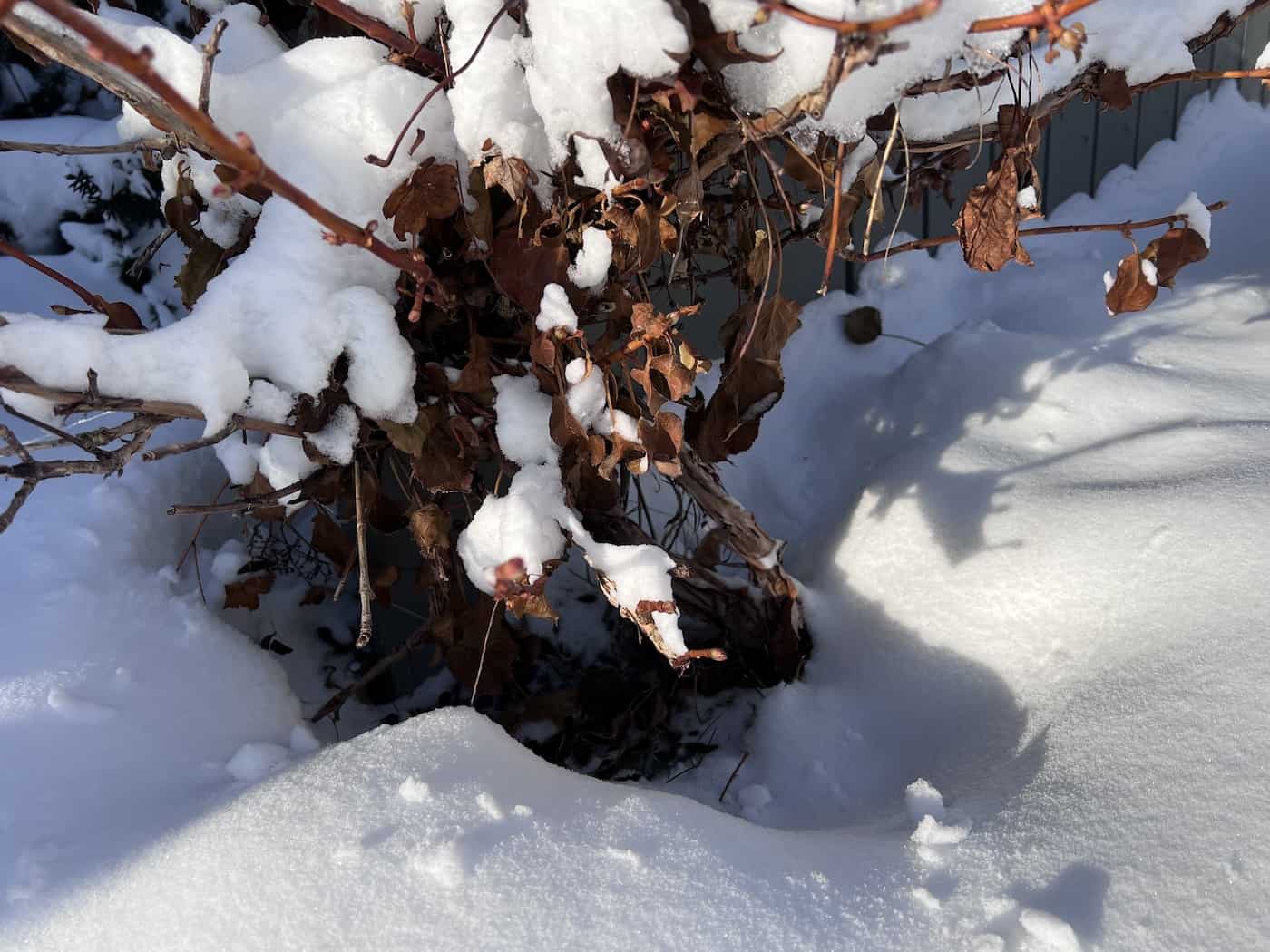
Dead, diseased, or damaged wood can and should be removed any time of year. Try not to cut the plant back too much since flowering occurs on old woody stems. If you cut off a significant amount of stems in winter or early spring, the plant will have very few flower buds left to bloom that spring.
Mulching is a great way to retain moisture in the soil during dry spells and prevent weeds from growing too close to the base structure of your climbing hydrangea. Use organic materials such as composted yard waste, straw, and/or grass clippings spread evenly around the base trunk and roots systems. Make sure to keep material away from actual stem trunks. Reapply annually when possible as older mulches break down faster over time, requiring replenishment each season.
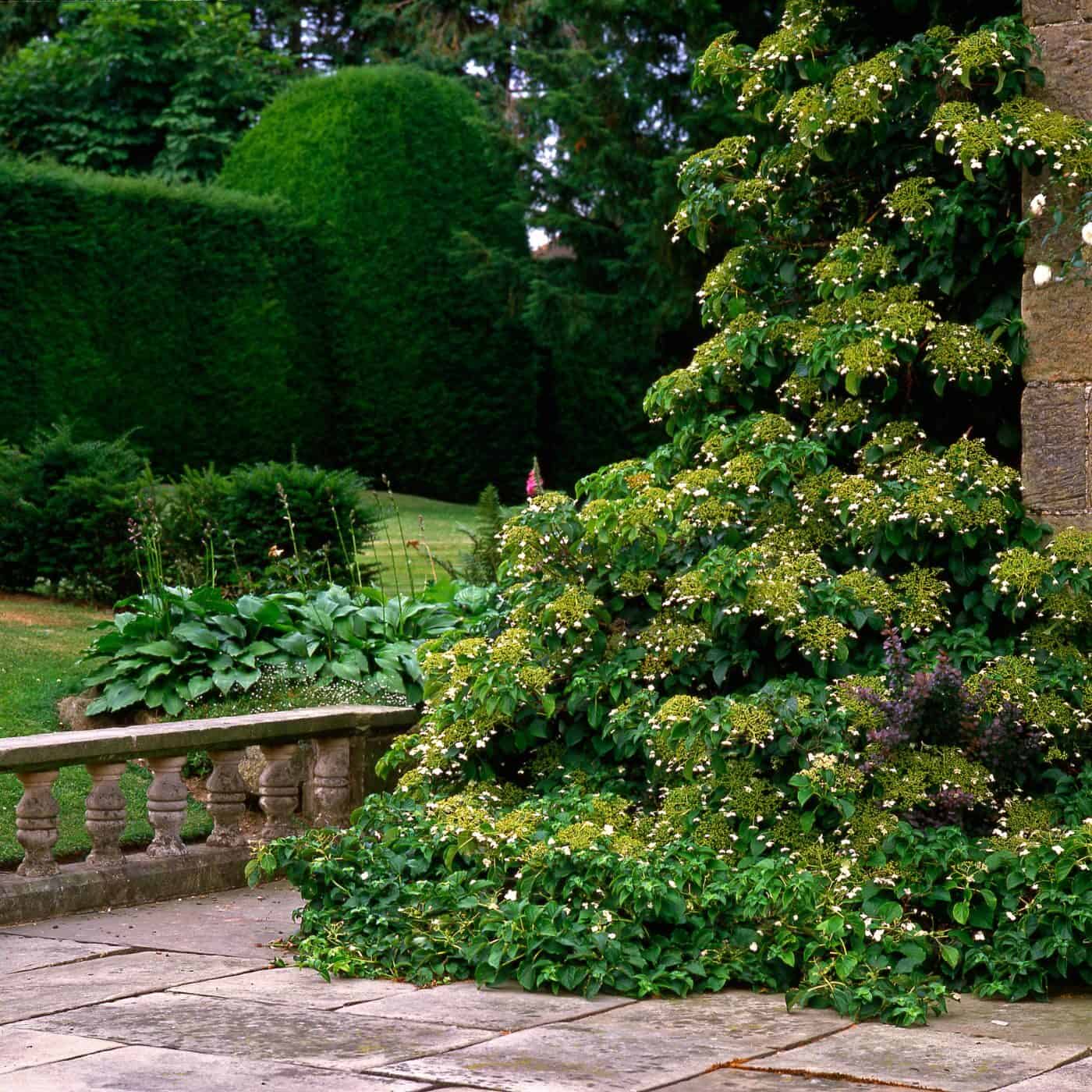
Watering climbing hydrangea plants
Watering climbing hydrangeas is an important part of keeping them healthy and happy. New plants need to be watered very frequently for the first 6-8 weeks and still quite often for the first year or two as their roots become established.
After the first couple of months, it’s best to transition to watering deeply but infrequently. About once a week should do it, unless it is quite hot and dry. This encourages deep root growth, which will help your plant survive dry spells later on.
When your hydrangea has been planted for more than about two years, you can usually reduce the watering frequency to every 7-10 days or so in hot weather and hopefully every 3-4 weeks during cooler months when rainfall is higher. Watering too much can cause root rot, so make sure not to overwater! You want the soil around your plant to be moist most of the time but not soggy.
To check if your hydrangea needs water, stick your finger into the soil near its base – if it feels dry, then give it some H2O! If you live in a hot climate with low humidity levels, you may need to increase watering frequency during dry seasons. However, be careful not to over-water, as this can be just as bad as too little.
If possible, use rainwater instead of tap water since chlorine found in tap water can damage foliage over time. Additionally, adding mulch to the soil surface around the base of your climbing hydrangea will help retain moisture between regular watering sessions and prevent weeds from taking over. Just don’t pile mulch up against the actual stems of the plant, as this can lead to rot. Leave a 6″ buffer to be safe.
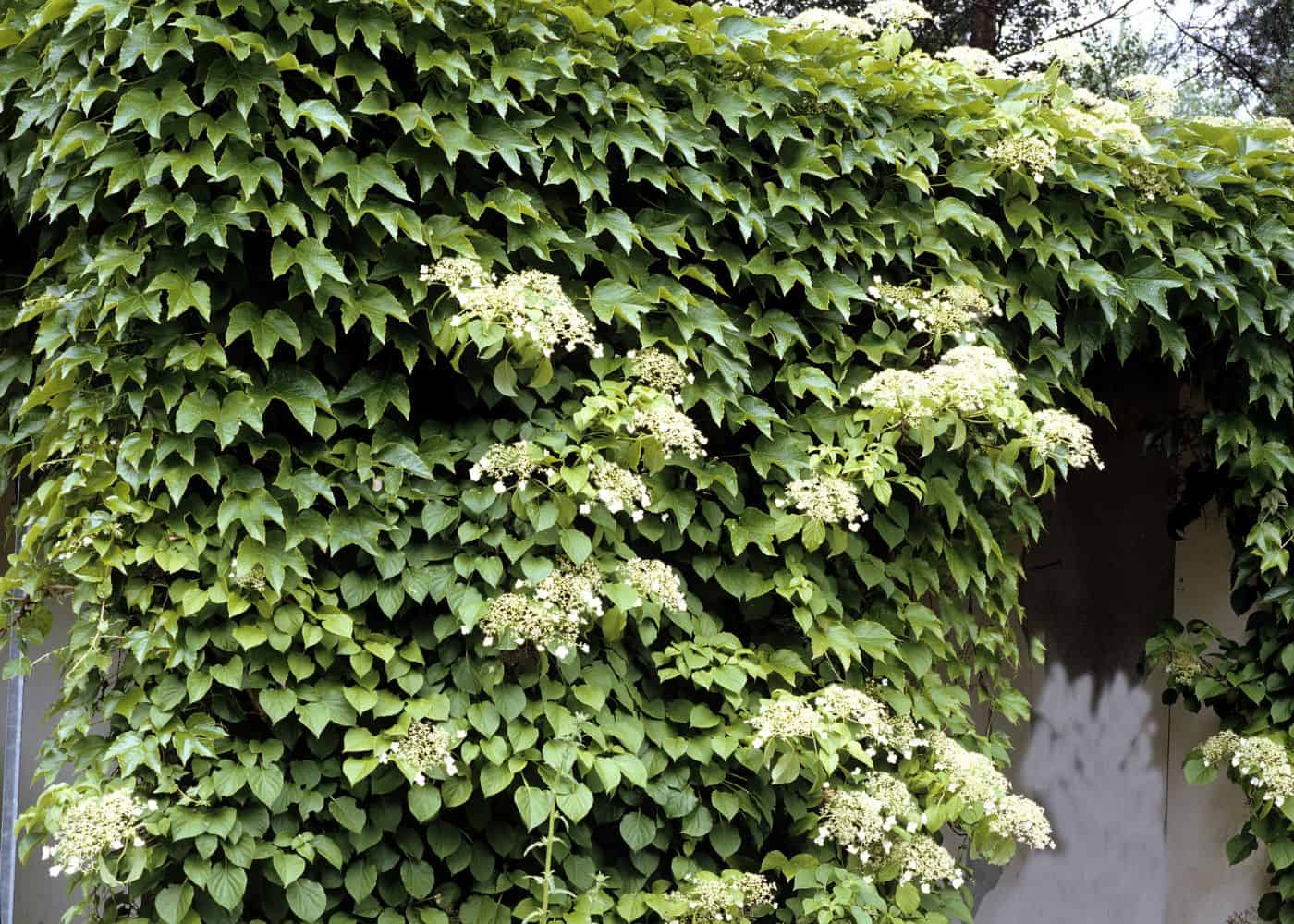
Fertilizing climbing hydrangeas
Fertilizing climbing hydrangeas is an important part of their care. As many urban soils aren’t particularly nutrient-dense, the right fertilizer can help ensure that your plants stay healthy and vigorous, and produce plenty of blooms each year.
Regarding fertilizers for climbing hydrangeas, the best choice is usually a slow-release fertilizer specifically designed for acid-loving plants such as azaleas or rhododendrons. These types of fertilizers will provide a steady supply of nutrients over time rather than all at once like some other types.
In the springtime, fertilizer before new growth begins to emerge. This is usually in March or April, depending on the local climate. This will give your plants a boost after winter dormancy and help them get off to a strong start for the season ahead.
Once flowering has finished in mid-summer (around July), you should apply another dose of slow-release fertilizer. Try not to do so too late in the season, as this could encourage new growth, which may not have enough time to harden off before winter arrives again!
Finally, if you notice any yellowing leaves during the summer months, then this could indicate nutrient deficiency; adding some liquid seaweed extract or fish emulsion can address this problem. Follow the instructions on the package and observe the plant regularly to note any signs of improvement.
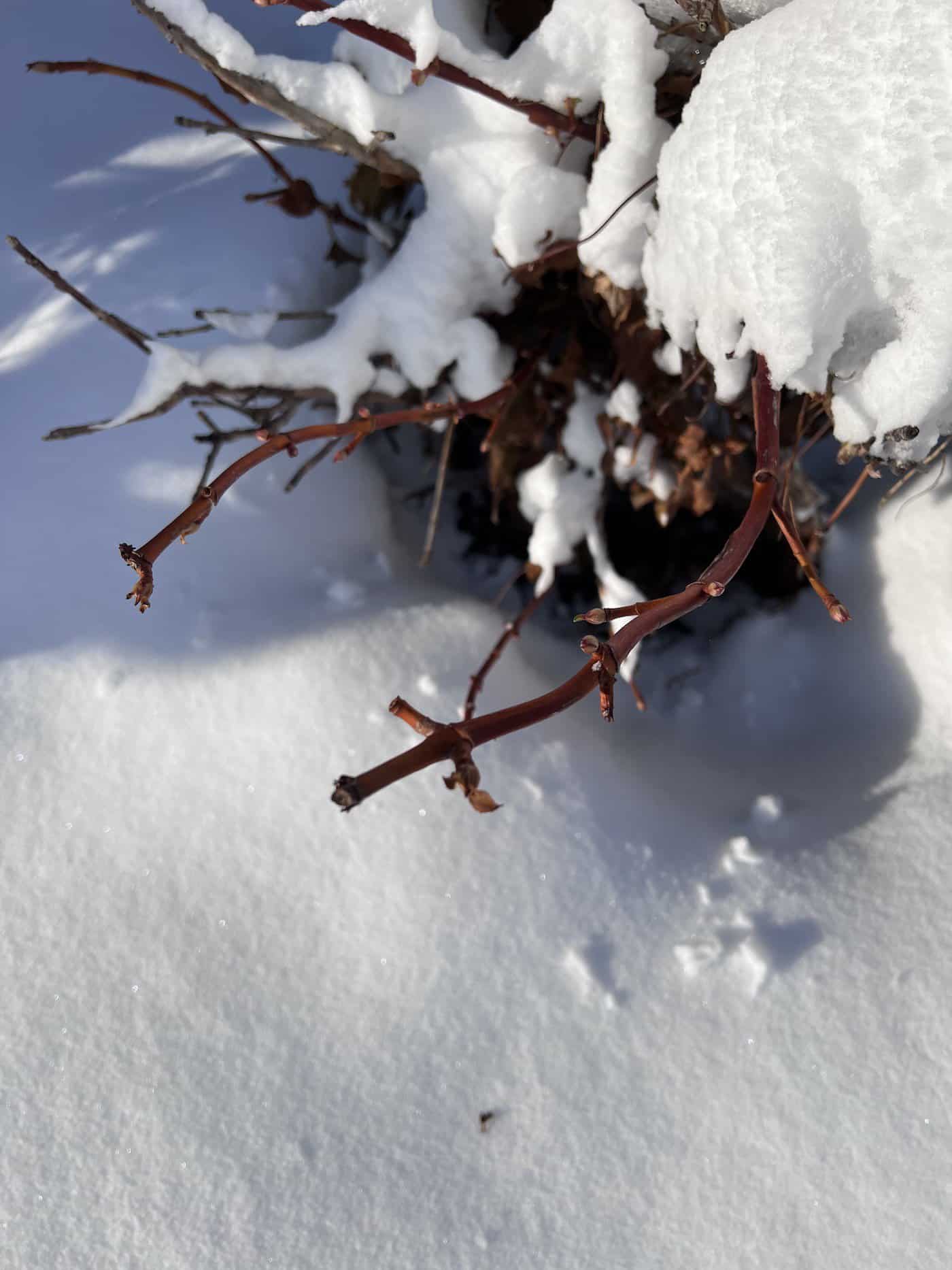
Pruning climbing hydrangea vines
Pruning climbing hydrangea vines is important to keeping your plants healthy and beautiful. The best time to prune them is in the summer after the flowers have faded, as pruning in spring will cut off flower buds and reduce blooming that year. You can prune them lightly in the fall as long as you are cognizant of not removing too many desired blooms.
Start the pruning session by cutting out any dead wood from the plant. This can be identified easily during the growing season as it will be brown or grayish-brown instead of green like the rest of the vine. Prune away all dead wood until you reach healthy living tissue, which should appear green and vibrant when you press gently on it with your finger or a pair of scissors.
Next, look for pairs of vines that are crossing over each other, rubbing, or growing too close together. These can be removed if you wish to increase air circulation between branches and encourage growth in other areas of the plant. It’s also a good idea to remove any weak stems growing in odd directions so they don’t become overcrowded later on. Finally, thin out some foliage if needed to give your climbing hydrangea more light exposure – this can help promote healthier growth overall if the plant is crowded.
When pruning climbing hydrangeas, always use sharp shears or scissors so that you get clean cuts without damaging any surrounding tissue. This will help prevent common bacterial and fungal diseases from entering through open wounds caused by jagged edges left behind by dull blades. Additionally, make sure not to take off too much at once. Try not to remove more than 1/3 of the plant’s foliage in one year. This way, you won’t shock your plant into dormancy and can keep its health up throughout the season while still maintaining its desired shape and size.
Finally, remember to clean up any debris afterward, such as fallen leaves or twigs, so that pests aren’t attracted near your plants, as this could lead to potential problems down the road if not taken care of properly. Disease-free yard trimmings can be shredded and composted to make a lovely composted mulch that can be placed back on top of the garden soil.
Mulching soil around hydrangeas
Mulching soil around hydrangeas is an important part of their care. It helps retain moisture, reduces weeds, and keeps the roots cool in summer. The best type of mulch to use for climbing hydrangeas is organic material such as composted yard waste trimmings or arborist mulch.
Spread a 2-3 inch layer of mulch over the entire root zone area (the space between the trunk and the edge of the leaf canopy). Avoid piling any mulch against the stem or trunk – this can cause rot. Don’t let the mulch touch the base of the plant itself. Keep about 3-6 inches away from stems and trunks when applying any kind of mulch.
Organic matter will slowly break down over time, so it’s important to replenish your supply each year with fresh material if needed. This will help ensure that your plant gets all the nutrients it needs while also keeping weeds at bay!
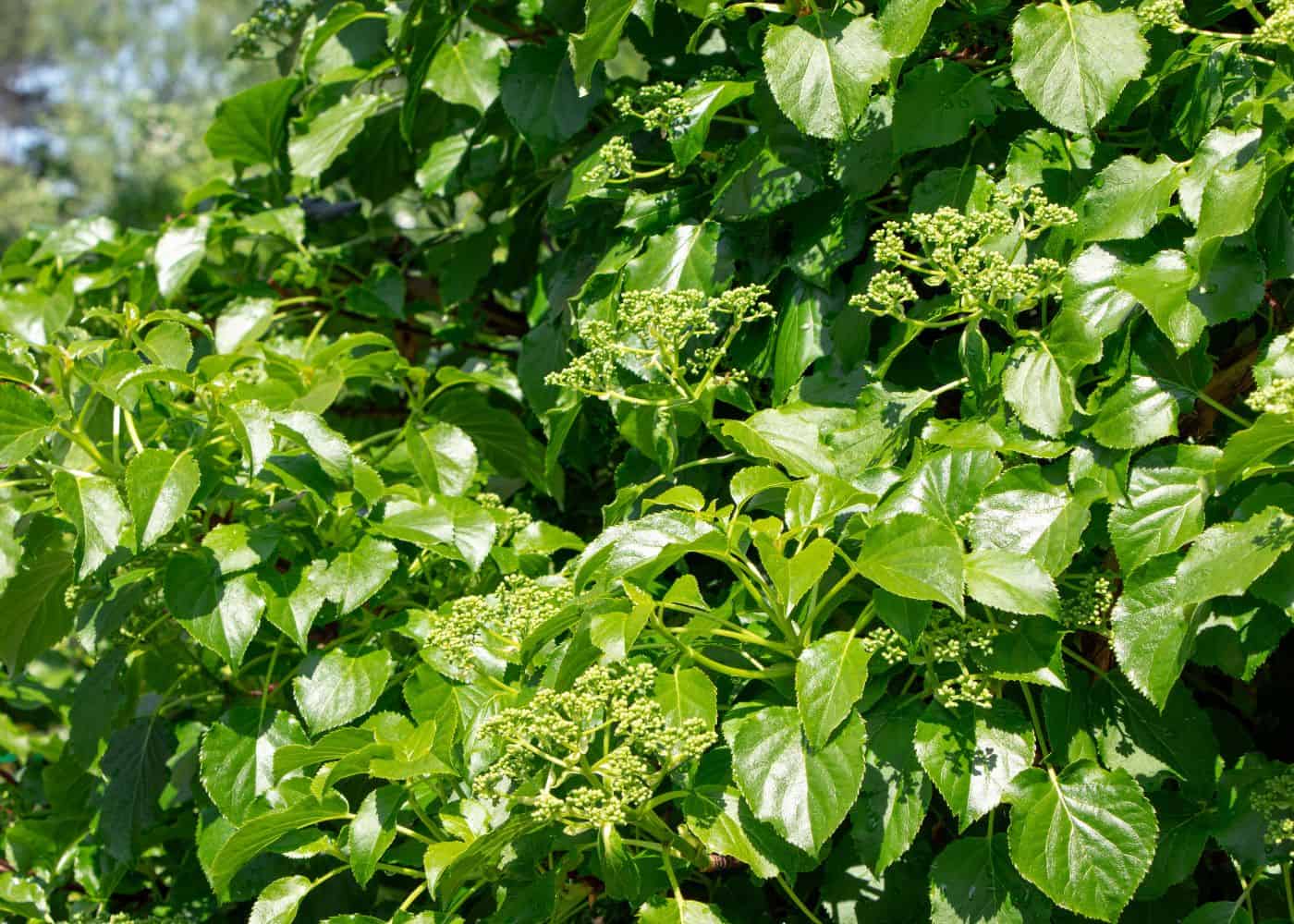
FAQs
Do you cut back climbing hydrangeas?
Climbing hydrangeas typically do not need to be cut back. These plants can be left to their own devices for the most part. Pruning generally consists of deadheading spent blooms and removing any branches that are dead, damaged, or diseased. If you are unsure how much to prune, it is always better to err on the side of caution and take off less than more.
If a climbing hydrangea does need to be cut back to the ground, it will usually grow back from the roots as long as they are strong and healthy. This can be a good way to rejuvenate an old plant, but it should only be done once (not every year or even every couple of years).
How do you take care of a climbing hydrangea in the winter?
Winter care for climbing hydrangeas is relatively simple. Before the coldest temperatures arrive, prune back any dead or damaged stems. Clean up fallen debris and remove dead leaves from the area. In very cold climates (Zones 3-4), you can provide a layer of winter protective mulch around the base of the plant to insulate it against extreme cold.
You should also water your hydrangea regularly in the fall if there is little rainfall. The plant should go into dormancy with ample water to protect against desiccating winds. Continue to water your climbing hydrangea deeply every few weeks if the ground is not frozen and there is no snow cover; this will ensure that its roots remain hydrated throughout winter dormancy.
Do climbing hydrangeas need sun?
Climbing hydrangeas do not necessarily need direct sun. They do prefer some direct sunlight for a fast growth rate and bountiful blooms, but these plants will usually also tolerate full shade. Expect the growth rate of climbing hydrangea plants to be quite a bit slower than expected when sited in full shade.
These plants are ideal for areas that don’t get a lot of direct sunlight or where the soil is dry and doesn’t retain moisture well. They also require less maintenance than other types of hydrangeas, making them an attractive option for busy homeowners who want to enjoy beautiful blooms without having to spend too much time tending their gardens.
How long does it take for a climbing hydrangea to grow?
A climbing hydrangea typically takes 5-10 years to reach its full height and width. It is a somewhat slow-growing plant, but it can grow quickly with the right care and attention.
The amount of time it takes for a climbing hydrangea to grow depends on the variety, climate, soil conditions, and other factors such as pruning or fertilizing. In general, if you provide your climbing hydrangea with plenty of sunlight and water, it should grow 1-2 feet per year until it reaches mature size. With proper care and patience, you will be able to enjoy its beauty in no time!


